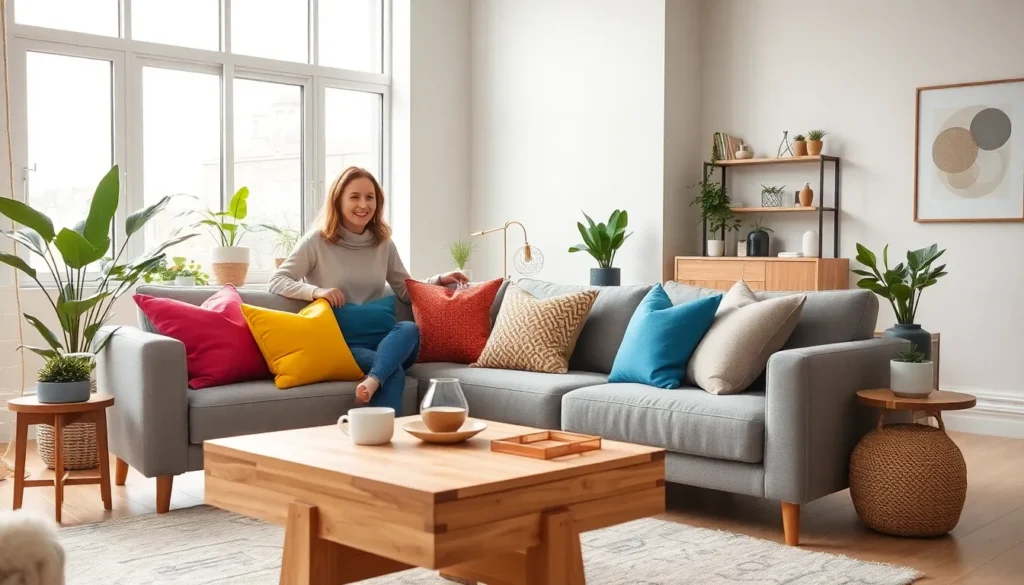In an increasingly complex world, holistic design emerges as a transformative approach that considers the interconnectedness of systems, environments, and human experiences. This methodology transcends traditional design boundaries, focusing on creating solutions that harmonize aesthetics, functionality, and sustainability. By embracing a comprehensive perspective, designers can craft spaces and products that resonate deeply with users while addressing broader societal and environmental challenges.
Holistic design isn’t just about the final product; it’s about the journey of creation itself. It encourages collaboration among diverse disciplines, fostering innovation and creativity. As more designers adopt this philosophy, they’re not only enhancing user satisfaction but also contributing to a healthier planet. Exploring the principles and practices of holistic design reveals how it can redefine the future of design in meaningful ways.
Table of Contents
ToggleUnderstanding Holistic Design
Holistic design encompasses a comprehensive methodology that prioritizes the connection between systems, environments, and human experiences. This approach integrates various elements to foster innovative solutions aligned with user needs.
Definition of Holistic Design
Holistic design refers to a method that emphasizes the interplay between various components within a project. It prioritizes user experience, environmental impact, and social relevance. This comprehensive approach seeks to create harmonious systems that address the multifaceted nature of design challenges.
Key Principles of Holistic Design
- Interconnectedness: Recognizes the relationships between different systems, ensuring that each design element complements others.
- User-Centric Approach: Focuses on the needs and experiences of users, guiding design decisions to enhance usability and satisfaction.
- Sustainability: Emphasizes eco-friendly materials and practices, reducing environmental impact across the lifecycle of a design.
- Collaboration: Encourages teamwork among diverse experts, fostering creativity and innovation through shared knowledge and perspectives.
- Adaptability: Designs must be flexible, allowing them to evolve and respond to changing needs and contexts over time.
The Importance of Holistic Design in Various Fields

Holistic design plays a crucial role across diverse fields, enhancing the functionality and sustainability of outcomes. Its integrative approach ensures solutions meet user needs while considering broader societal and environmental impacts.
Holistic Design in Architecture
Holistic design in architecture fosters environments that promote well-being and functionality. It integrates natural elements, sustainable materials, and energy-efficient technologies. Architects prioritize the relationship between structures and their surroundings, creating spaces that enhance user experience. For example, biophilic design connects humans with nature through light, greenery, and open layouts. Emphasizing community needs, architects design public spaces that encourage social interaction and inclusivity.
Holistic Design in Product Development
Holistic design in product development streamlines processes to create user-centered products. Designers gather insights from various disciplines, ensuring products are aesthetically pleasing and functional. By focusing on the entire lifecycle of a product, from materials to disposal, they minimize environmental impact. For instance, companies like Apple incorporate sustainable practices, utilizing recyclable materials and designing for longevity. This comprehensive approach results in products that resonate with users while addressing ecological concerns.
Holistic Design in User Experience
Holistic design in user experience (UX) prioritizes meaningful interactions between users and systems. Designers analyze user behavior and context to deliver cohesive experiences across platforms. They blend aesthetics, accessibility, and functionality, ensuring intuitive navigation and satisfaction. For example, leading tech companies implement user feedback loops to adapt designs continually. By fostering emotional connections, holistic UX design enhances engagement and loyalty, driving long-term success.
Benefits of Implementing Holistic Design
Holistic design offers significant advantages across various domains. It fosters creativity, enhances user experiences, and promotes sustainability in design practices.
Enhanced Creativity and Innovation
- Encourages diverse thinking: Holistic design incorporates input from various disciplines, stimulating innovative solutions.
- Inspires cross-pollination: Collaboration between teams fosters new ideas, leading to creative breakthroughs not possible in siloed environments.
- Supports iterative processes: Holistic design promotes experimentation, allowing for constant refinement and improvement of concepts.
Improved User Satisfaction
- Prioritizes user experience: Holistic design focuses on user needs, resulting in products and spaces that resonate with individuals.
- Facilitates engagement: It creates meaningful interactions tailored to user behaviors and contexts, enhancing overall satisfaction.
- Increases usability: By addressing various aspects of design, such as accessibility and functionality, it fosters user-friendly environments and products.
Sustainability and Environmental Impact
- Reduces resource consumption: Holistic design emphasizes efficient use of materials and energy, contributing to lower environmental footprints.
- Promotes lifecycle thinking: It considers the entire lifecycle of products, ensuring sustainable practices from inception through disposal.
- Encourages social responsibility: Holistic design addresses societal challenges, integrating solutions that benefit both communities and the environment.
Challenges in Adopting Holistic Design
Adopting holistic design presents various challenges. Resistance to change and the integration of diverse disciplines often complicate the process.
Resistance to Change
Resistance exists within organizations as stakeholders may favor traditional design methodologies. Stakeholders frequently prioritize short-term outcomes over the long-term benefits of holistic design, which can hinder its adoption. Additional concerns include the perceived complexity of the holistic approach, leading to hesitance in moving away from established processes. Training staff and communicating the long-term advantages can help in overcoming this resistance.
Integration of Diverse Disciplines
Integration of diverse disciplines poses another challenge in holistic design. Collaboration across various fields such as engineering, architecture, and social sciences might face obstacles like differing terminologies or varying project goals. Successful holistic design requires a unified vision and effective communication among team members. Developing structured frameworks for collaboration can facilitate this integration and promote a cohesive approach to problem-solving. This fostering of interdisciplinary relationships enhances the potential for truly innovative solutions.
Holistic design represents a pivotal shift in how designers approach complex challenges. By embracing interconnectedness and prioritizing user experiences alongside sustainability, it creates solutions that are not only functional but also resonate deeply with users. This approach fosters innovation through collaboration across diverse disciplines, ensuring that design is responsive to both societal needs and environmental concerns.
While adopting holistic design may come with challenges, the potential benefits far outweigh the obstacles. As organizations begin to embrace this comprehensive methodology, they can pave the way for a future where design is more meaningful and impactful. The journey toward holistic design is not just about creating better products or spaces; it’s about fostering a more sustainable and harmonious world for everyone.









